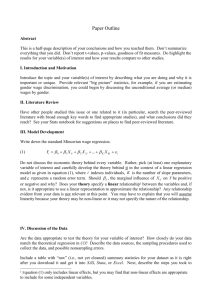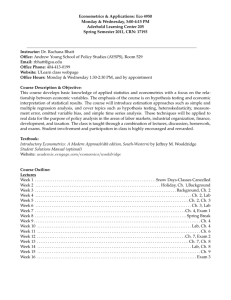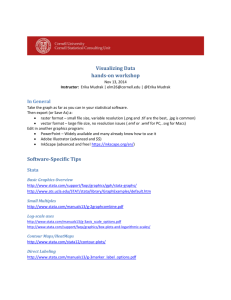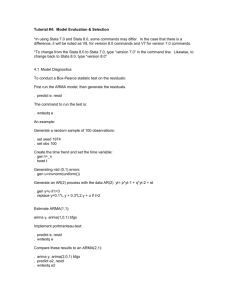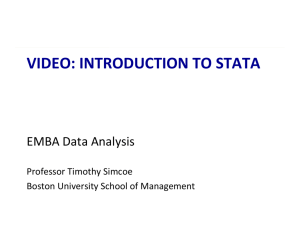course content - University of Washington
advertisement
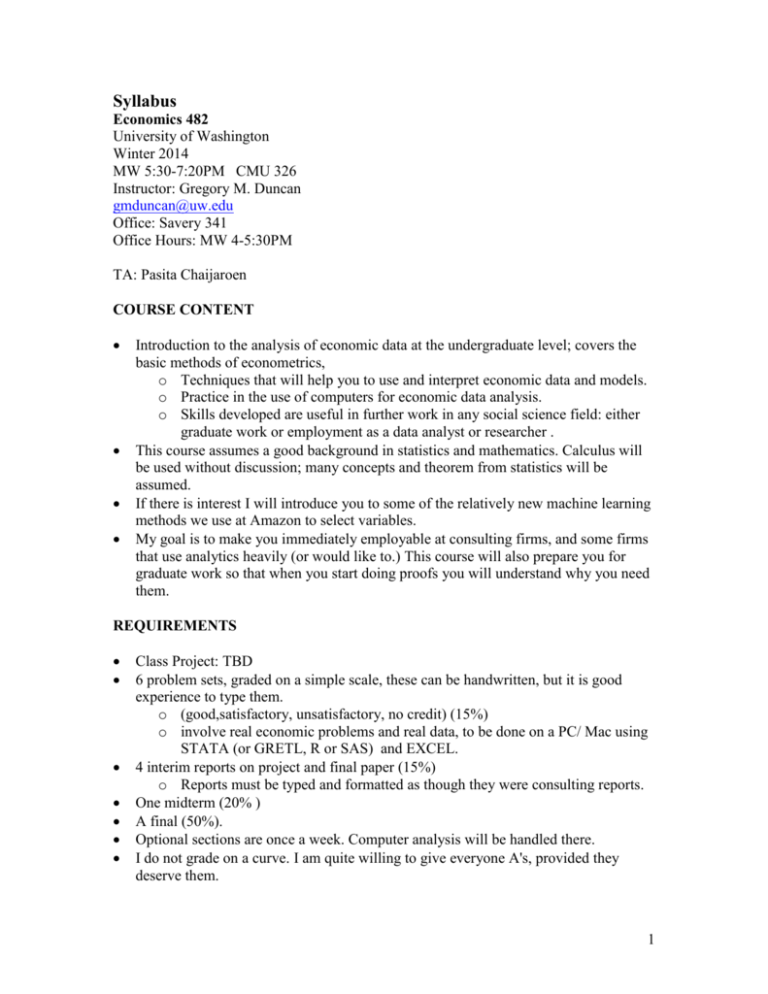
Syllabus Economics 482 University of Washington Winter 2014 MW 5:30-7:20PM CMU 326 Instructor: Gregory M. Duncan gmduncan@uw.edu Office: Savery 341 Office Hours: MW 4-5:30PM TA: Pasita Chaijaroen COURSE CONTENT Introduction to the analysis of economic data at the undergraduate level; covers the basic methods of econometrics, o Techniques that will help you to use and interpret economic data and models. o Practice in the use of computers for economic data analysis. o Skills developed are useful in further work in any social science field: either graduate work or employment as a data analyst or researcher . This course assumes a good background in statistics and mathematics. Calculus will be used without discussion; many concepts and theorem from statistics will be assumed. If there is interest I will introduce you to some of the relatively new machine learning methods we use at Amazon to select variables. My goal is to make you immediately employable at consulting firms, and some firms that use analytics heavily (or would like to.) This course will also prepare you for graduate work so that when you start doing proofs you will understand why you need them. REQUIREMENTS Class Project: TBD 6 problem sets, graded on a simple scale, these can be handwritten, but it is good experience to type them. o (good,satisfactory, unsatisfactory, no credit) (15%) o involve real economic problems and real data, to be done on a PC/ Mac using STATA (or GRETL, R or SAS) and EXCEL. 4 interim reports on project and final paper (15%) o Reports must be typed and formatted as though they were consulting reports. One midterm (20% ) A final (50%). Optional sections are once a week. Computer analysis will be handled there. I do not grade on a curve. I am quite willing to give everyone A's, provided they deserve them. 1 This is a hard course. But I have taught a variant of it the last 12 years at Berkeley, I can guarantee you if you put in the time and effort, you will get a huge amount out of it: one hopes at a minimum, a job or a really good grad school. TEXTS Required: o Introductory Econometrics: A Modern Approach 4th Ed. (Jeffrey Wooldridge) PREREQUISITES some economics o Economics 300 and some macro some calculus and math o Integral and Differential Calculus Math 124 would be fine o Basic exposure to matrices (I assume most of you saw matrices in high school). I will not do matrix derivations, but for notational sanity and to allow you to read empirical papers they are essential. o You can, in principle, determine when you can solve and, if appropriate, then solve n linear equations in n unknowns. statistics o Basic understanding of probability distributions o Basic understanding of testing Readings and Content: I’ll add or delete as I go along. At a minimum we will cover Chapters 1-10 plus Appendices A-E from Wooldridge (W). Before first class W Chapter 1, Appendices A,B,C W Chapter 19 (for the first time) First Section: Quiz in Section on Basics (graded as a homework, very, very simple, but if you do poorly you don't have the background for the course and should drop it). W Appendix D (Matrices; done in Section) W Chapter 2 W Chapter 3, Appendix E W Chapter 4 W Chapter 5 W Chapter 6 W Chapter 19 (for the second time) Exam on Regression 2 W Chapter 7 W Chapter 8 W Chapter 10 W Chapter 19 (for the third time) W Chapter 13 W Chapter 15 W Chapter 16 Final: Comprehensive Software: We will be teaching STATA, R and using EXCEL. But I’d recommend learning SAS as you go, because it can get you a job. However, SAS has made it really difficult to deal with them, so I will use the easier, but less industry oriented STATA. With SAS you must renew your license every year, once you are no longer a student it can cost thousands of dollars. Advanced students might want to use R, which we use at Amazon, however, that language has a steep learning curve. But make sure you can use STATA as well as many firms do not yet use R. STATA: For STATA go to the STATA site (URL below) and look at these two versions. Either should be adequate for this course. You might want to consider a perpetual license for $179, because the Student licenses have restrictions, the perpetual license you can take with you. STATA (STUDENTS ONLY) : Stata/IC 12 software with Getting Started Manual (Windows, Macintosh and Linux) 98.00/annual Small Stata 12 software with Getting Started Manual (Windows and Macintosh ONLY) 49.00/annual http://www.washington.edu/itconnect/wares/uware/stata/ SAS: SAS can get you a job. Here is the link. http://www.washington.edu/itconnect/wares/uware/sas/ Very steep learning curve, but SAS can handle huge datasets, STATA cannot. Here is a link to Phil Spector's very fine SAS tutorial http://www.stat.berkeley.edu/classes/s100/sas.pdf Other Software: 3 There is freeware called GRETL. http://gretl.sourceforge.net/ It is really quite good. No one will give you a job because you know GRETL however. If you really want to learn this stuff, program it yourself using R. http://cran.r-project.org/ If you are planning to take my new course Data Science for Economists in Spring 2014, R will be a requirement. I will accept homework written using all. But you cannot be late because you could get your code to work. Also, tests will be based on STATA form of output, so you’ll need to master that. Also useful is to see what Federal Judges expect from econometric work presented in courts. Here is an URL to the Reference Manual on Scientific Evidence. Federal judges use these manuals (one is for multivariate regression, another for basic statistics). http://www.fjc.gov/public/pdf.nsf/lookup/sciman00.pdf/$file/sciman00.pdf 4

